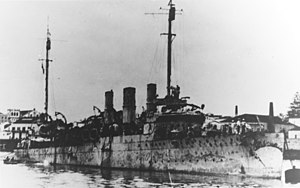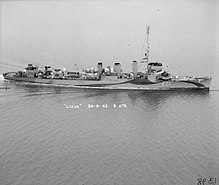
The first USS Abbot (DD-184) was a Wickes-class destroyer in the service of the United States Navy until traded to Britain at the beginning of World War II. She served in the Royal Navy as HMS Charlestown (I21), a Town-class destroyer.
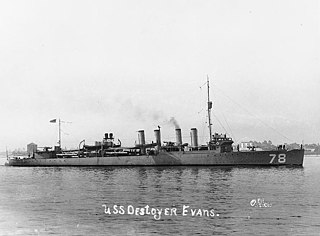
The first USS Evans (DD–78) was a Wickes-class destroyer in the United States Navy during World War I, later transferred to the Royal Navy as HMS Mansfield.

USS Sigourney (DD–81) was a Wickes-class destroyer in the United States Navy during World War I. She was the first ship named for James Butler Sigourney.

USS Robinson (DD-88) was a Wickes-class destroyer in the United States Navy, later transferred to the Royal Navy, as HMS Newmarket (G47). She was the first ship named for Isaiah Robinson.

USS Fairfax (DD-93) was a Wickes-class destroyer in the United States Navy during World War I, later transferred for World War II service first to the Royal Navy as HMS Richmond (G88), a Town-class destroyer, and then to the Soviet Navy as Zhivuchy.
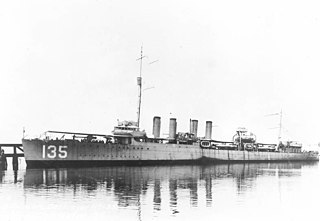
The first USS Tillman (DD–135) was a Wickes-class destroyer in the United States Navy. She was named for Senator Benjamin Tillman. Transferred to the United Kingdom in World War II, she was commissioned in the Royal Navy as HMS Wells.

USS Maddox (DD–168) was a Wickes-class destroyer in the United States Navy during World War I. She was later transferred to the Royal Navy as HMS Georgetown (I-40), to the Royal Canadian Navy as HMCS Georgetown, and then to the Soviet Navy as Doblestny . She was the last "four piper" destroyer to be scrapped.

The second USS Foote (DD–169) was a Wickes-class destroyer in the United States Navy following World War I. She was transferred to the Royal Navy as HMS Roxborough (I07) and later to the Soviet Navy as Zhyostky.

The first USS Kalk (DD–170) was a Wickes-class destroyer in the United States Navy during World War I, later transferred to the Royal Navy as HMS Hamilton (I24) and then into the Royal Canadian Navy as HMCS Hamilton (I24).

The first USS Hopewell (DD–181) was a Wickes-class destroyer in the United States Navy, entering service in 1919. After a brief active life, the ship was deactivated in 1922 and placed in reserve for 18 years before returning to service in 1940 during World War II. She was later transferred to the Royal Navy as HMS Bath (I17), as a Town-class destroyer, and then to the Royal Norwegian Navy as HNoMS Bath. Bath was torpedoed while escorting a trans-Atlantic convoy on 19 August 1941.

USS Craven (DD-70), later renamed USS Conway (DD-70), a Caldwell-class destroyer, was in commission in the United States Navy from 1918 to 1922 and briefly in 1940, and later in the Royal Navy as HMS Lewes from 1940 to 1945.

USS Satterlee (DD-190) was a Clemson-class destroyer in the United States Navy, entering service in 1919. After brief service until 1922, the ship was placed in reserve. The ship was reactivated for World War II before being transferred to the Royal Navy in 1940. Renamed HMS Belmont, the destroyer was used as a convoy escort in the Battle of the Atlantic where she was torpedoed and sunk on 31 January 1942.

USS Mason (DD-191) was a Clemson-class destroyer in the United States Navy during World War II. She was later transferred to the Royal Navy as HMS Broadwater (H81).

The first USS McCook (DD-252) was a Clemson-class destroyer in the United States Navy. Entering service in 1919, the ship had a brief active life before being placed in the reserve fleet. Reactivated for World War II, the ship was transferred to the Royal Navy and then to the Royal Canadian Navy and renamed HMCS St. Croix. Assigned as a convoy escort in the Battle of the Atlantic, St. Croix was torpedoed and sunk on 20 September 1943.

The second USS Bancroft (DD-256) was a Clemson-class destroyer in the United States Navy, which briefly served in 1919. Placed in reserve, the ship lay idle before being reactivated for World War II. She was transferred to the Royal Canadian Navy in 1940, where she served as HMCS St. Francis (I93) in the Battle of the Atlantic escorting convoys. The ship was declared surplus in April 1945, sold for scrap and sank on the way to the breakers after a collision in July.
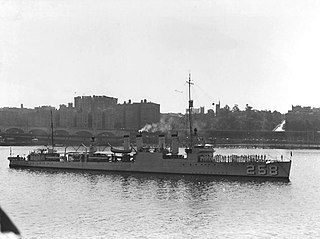
The second USS Aulick (DD-258) was a Clemson-class destroyer in the United States Navy and transferred to the Royal Navy where she served as HMS Burnham (H82) during World War II.

The first USS Laub (DD-263) was a Clemson-class destroyer in the United States Navy and transferred to the Royal Navy where she served as HMS Burwell (H94) during World War II. She was named for Henry Laub.

The first USS McLanahan (DD-264) was a Clemson-class destroyer in the United States Navy and transferred to the Royal Navy where she served as HMS Bradford (H72) during World War II.

The eighth HMS Worcester, was a Modified W-class destroyer of the British Royal Navy that saw service in World War II. She later served as an accommodation ship as the second HMS Yeoman.

HMS Douglas was an Admiralty type flotilla leader of the British Royal Navy. Built by Cammell Laird, Douglas commissioned in 1918, just before the end of the First World War. During the Second World War, Douglas served with Force H out of Gibraltar and as a convoy escort. She was sold for scrap in March 1945.
